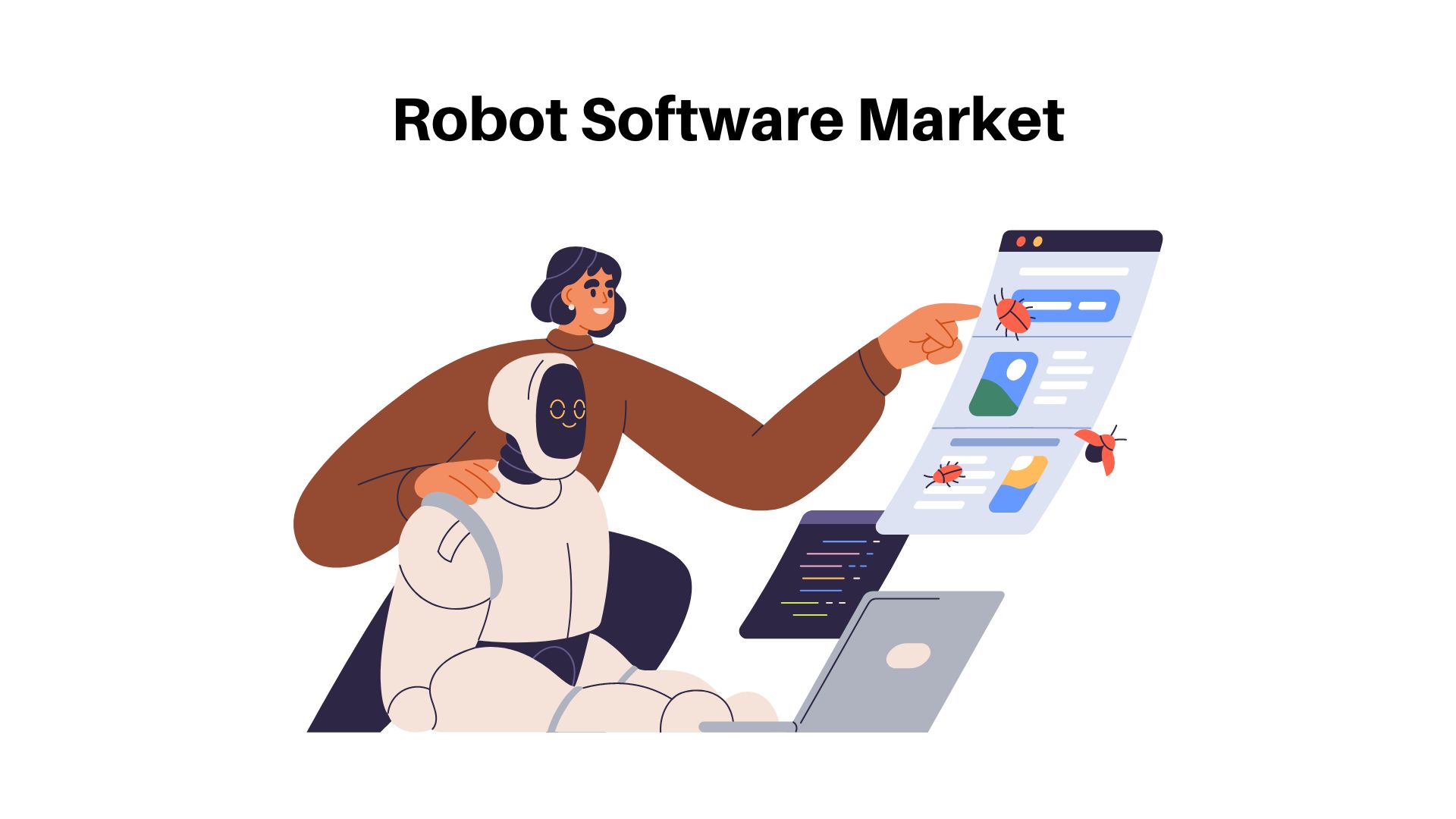Robot Software Market to Reach USD 326.9 Billion by 2032, Says Market.us Research Study

Page Contents
Market Overview
Published Via 11Press: The Robot Software Market size is expected to be worth around USD 326.9 Bn by 2032 from USD 7.53 Bn in 2022, growing at a CAGR of 45.8% during the forecast period from 2022 to 2032.
The market has witnessed a significant boom in recent years. This growth can be attributed to the increasing adoption of automation technology across various industries, including manufacturing, healthcare, and retail. The demand for robot software is expected to continue rising in the coming years as enterprises seek to streamline their operations and increase efficiency.
Robot software refers to the programming languages that enable robots to perform specific tasks such as assembly line work or customer service interactions. With advancements in artificial intelligence and machine learning technologies, modern robot software has become increasingly sophisticated, allowing robots to learn from experience and adapt to changing environments. As a result, businesses are investing heavily in this area of technology with the goal of reducing labor costs while improving productivity.
Overall, the Robot Software market presents exciting opportunities for both established players and new entrants into the industry.
Request For Sample Report Here: https://market.us/report/robot-software-market/request-sample/

Key Takeaways
- The market for robot software is a rapidly growing industry, driven by the increasing demand for automation across various industries and advancements in artificial intelligence and machine learning.
- The market includes both software for industrial robots used in manufacturing and software for service robots used in healthcare, education, and entertainment.
- The global robot software market size is expected to reach USD 326.9 billion by 2032, growing at a CAGR of 45.8% during the forecast period of 2022-2032.
- Key players in the robot software market include IBM, ABB, Nvidia, Cloudminds, Liquid Robotics, Brain Corp, Aibrain, Furhat Robotics, Neurala, Energid Technologies, H2o.AI, Oxbotica
- The increasing adoption of automation and robotics in various industries presents opportunities for both established companies and new entrants to develop innovative software solutions to meet the growing demand for robot software.
- The robot software market is expected to continue to grow rapidly in the coming years, driven by advancements in technology, increasing demand for automation, and the need for more efficient and cost-effective solutions in various industries.
Market Overview
North America is one of the leading regions in the robot software market, thanks to companies such as iRobot Corporation and Brain Corp, along with the increasing adoption of automation across industries such as manufacturing, healthcare, and logistics.
Europe is a major player in the robot software market, boasting an extensive presence in the manufacturing and automotive industries. Countries such as Germany, the UK, and France are key players within this region.
The Asia-Pacific region is witnessing a remarkable expansion in the robot software market, due to the presence of key manufacturing hubs and increasing adoption of automation in countries like China, Japan, and South Korea.
The Latin America region is expected to witness significant growth in the robot software market, due to the increasing adoption of automation across industries such as manufacturing, healthcare, and logistics.
The Middle East and Africa region is expected to experience growth in the robot software market, driven by increased automation in industries such as oil & gas, mining, and construction.
Overall, the market is witnessing growth across various regions due to the increasing adoption of automation in industries and the need for efficient yet cost-effective solutions. The Asia-Pacific region is expected to experience significant expansion over the coming years, driven by key manufacturing hubs and increased automation across various sectors.
Drivers
Increasing Demand for Automation The rising demand for automation across various industries, such as manufacturing, healthcare, and logistics is one of the major driving forces in the robot software market. This trend is being spurred on by a need for efficient and cost-effective solutions that boost productivity while decreasing labor costs. Advances in Artificial Intelligence and Machine Learning The advancements in artificial intelligence and machine learning technologies are propelling the growth of the market. These systems enable robots to learn from their environment, making them more intelligent and efficient overall.
Growing Demand for Customized and Flexible Solutions Companies are searching for software solutions that are easy to customize and integrate into their existing systems, making it simpler to adjust according to changing business demands. The Growing Demand for Service Robots The growing need for service robots in various applications such as healthcare, education, and entertainment is propelling the growth of the robot software market. To enable these machines to function efficiently and safely, specialized software must be provided. Growing Investments in Robotics Governments, research institutions, and private companies are increasingly investing in robotics and automation technologies. This activity is fueling innovation and the creation of new software solutions that can further enhance robot capabilities.
Overall, the robot software market is being driven by a need for more efficient and cost-effective solutions, advances in technology, and an increasing desire for customized and flexible solutions. As more industries adopt automation and robotics technologies, the market is expected to expand over the coming years.
Purchase This Report At Discounted Rate Here: https://market.us/purchase-report/?report_id=12860
Restraints
High Costs The high costs associated with developing and implementing robot software could be a major deterrent for the market. The expenses of creating and testing software can be substantial, making it challenging for some companies to adopt robot software solutions. Lack of Skilled Workforce The lack of skilled personnel in robotics and automation could pose a major barrier to growth in the robot software market. There is an urgent need for software developers and engineers who possess the expertise to design and implement robot software solutions thus, a shortage of these professionals could restrict market expansion.
Security Concerns Security issues associated with robot software could prove a major barrier to growth in this market. As robots become more intelligent and connected, there is an increased risk of cyber attacks or security breaches which could compromise both their safety and that of any data they handle. Ethical Concerns The increasing adoption of robots across various industries has raised ethical issues, particularly related to job displacement and privacy. This could limit the adoption of robot software solutions, particularly in industries with strong opposition against automation. Regulatory Issues A lack of standardization and regulation in robotics and automation could be a major impediment to the robot software market. Without clear regulations, companies may find it challenging to develop and implement robot software solutions.
Overall, the robot software market is expected to experience continued growth over the coming years however, certain restraints could slow its momentum in the near future. Thus, addressing these obstacles is vital for maintaining this momentum within the sector.
Opportunities
Cloud-Based Robot Software The development of cloud-based robot software solutions could present a major opportunity for the market. Cloud-based solutions offer several advantages, such as increased scalability, simpler deployment, and superior data management. Expansion into Emerging Markets The expansion of robot software solutions into emerging markets such as India and Southeast Asia could present a major opportunity for the market. These regions are experiencing rapid growth across various industries, and adopting robot software solutions could be an important catalyst in driving that expansion. Integration with Other Technologies Combining robot software and the Internet of Things (IoT) could present significant market prospects. IoT allows robots to communicate with other devices and sensors, giving them a more comprehensive view of their environment.
Development of Specialized Software The development of robot software solutions tailored towards specific industries or applications such as healthcare or agriculture could represent an exciting prospect for the market. Customized and efficient solutions are possible through specialized software programs. Advancements in Robot Software Capabilities The continued advancements in robot software capabilities, such as increased autonomy, adaptability, and intelligence, could present an exciting opportunity for the market. These improvements allow robots to perform more complex tasks and operate in various environments.
Overall, there are numerous opportunities in the robot software market that will fuel growth and innovation over the coming years. Companies that take advantage of these advantages by creating innovative solutions and expanding into new markets could see great success on this front.
Challenges
The complexity of Robot Software can be intricate, requiring specialized knowledge and skills to design and implement. This complexity may make it challenging for companies to adopt robot solutions and integrate them into their current systems. Interoperability Lack of standardization in robotics and automation can make it challenging for robot software solutions to integrate with other systems and technologies. This poses a major obstacle for companies seeking to adopt robot software solutions. Data Privacy and Security As robots become more interconnected and intelligent, there is an increasing concern about data privacy and security. To protect against unauthorized access or cyber-attacks, robots must secure their collected information.
Limited Flexibility Some robot software solutions may be tailored towards specific use cases, making them less adaptable and customizable to different environments and applications. This could limit the potential applications of such solutions. Competition from Open-Source Software, Open-source robot software solutions present a challenge for commercial robot software providers since these programs can be developed and shared freely. As such, price competition between commercial providers may become an issue.
Overall, the complexity of robot software, lack of standardization, data privacy, and security issues, limited flexibility, and competition from open-source software are some of the challenges facing this market. Resolving these issues will be key for sustained growth and adoption of robotic software solutions.
Recent Development
In May 2022 Qisda announced its partnership with MOV.AI in order to power its autonomous mobile robotics. The robotics engine platform will be used by the company to supply its customers with robots for handling dangerous jobs and automation.
In October 2021 Singapore’s Defence Science and Technology Agency announced its partnership with Ghost Robotics, a Philadelphia-based company. The goal of the partnership is to identify use cases involving legged robotics for security, defense, and humanitarian purposes. Both companies will develop and test mobile robotic systems, as well as the technology enablers necessary to deploy them in harsh urban environments.
August 2021 Fomento Economico Mexicano, one of the largest Latin American food and beverage distributors and convenience store operators, has invested a significant amount through its corporate venture fund in Swyft, Inc., which is a major player in the software-powered robotics market. This partnership will allow Swyft to deploy its software and robotics technology on a future scale. It provides unattended delivery for merchants, brands, and last-mile providers.
Report Scope
| Report Attribute | Details |
| The market size value in 2022 | USD 7.53 Bn |
| Revenue forecast by 2032 | USD 326.9 Bn |
| Growth Rate | CAGR Of 45.8% |
| Regions Covered | North America, Europe, Asia Pacific, Latin America, and Middle East & Africa, and the Rest of the World |
| Historical Years | 2017-2022 |
| Base Year | 2022 |
| Estimated Year | 2023 |
| Short-Term Projection Year | 2028 |
| Long-Term Projected Year | 2032 |
Key Market Segments
Type
- Recognition software
- Simulation software
- Predictive maintenance software
- Data management and analysis software
- Communication management software
Application
- Industrial robots
- Service robots
Key Market Players included in the report:
- IBM
- ABB
- Nvidia
- Cloudminds
- Liquid Robotics
- Brain Corp
- Aibrain
- Furhat Robotics
- Neurala
- Energid Technologies
- H2o.AI
- Oxbotica
Frequently Asked Questions
What is the market study period?
The Robot Software Market is studied from 2017 – 2032.
What is the growth rate for the Robot Software Market?
The Robot Software Market is growing at a CAGR of 45.8%
Which region experiences the highest rate of growth in the Robot Software Market?
Asia Pacific is growing at the highest CAGR over 2022- 2032.
Which region is the largest in the Robot Software Market?
North America holds the highest share in 2022.
Who are the major players in the Robot Software Market?
IBM, ABB, Nvidia, Cloudminds, Liquid Robotics, Brain Corp, Aibrain, Furhat Robotics, Neurala, Energid Technologies, H2o.AI, Oxbotica
The team behind market.us, marketresearch.biz, market.biz and more. Our purpose is to keep our customers ahead of the game with regard to the markets. They may fluctuate up or down, but we will help you to stay ahead of the curve in these market fluctuations. Our consistent growth and ability to deliver in-depth analyses and market insight has engaged genuine market players. They have faith in us to offer the data and information they require to make balanced and decisive marketing decisions.



